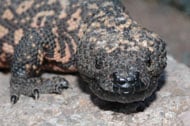Gila Monster
Parts of Arizona, Nevada, New Mexico, Utah and Mexico.
Although this is a dangerously venomous lizard, hobbyists have embraced its colorful form into herpetoculture. Care must always be maintained because it’s easy to be lulled into thinking they’re ‘tame’ and can be handled freely without fear of a bite.
The Gila monster thrives in a spacious cage if a mixture of dry sand and gravel is used to mimic its natural desert terrain. Add extra rocks and dead wood or cholla cactus limbs, but don’t be surprised if captive Gila monsters constantly rearrange them as they dig around. They love to burrow, and the exercise helps keep their long claws worn down in captivity.
Gila monsters are active day or night depending on the season and ambient temperature, but the majority of their daily routine involves resting underground in burrows. For this reason, providing a situation where Gila monsters can tuck themselves away in a burrow will help keep them comfortable. It doesn’t hurt to occasionally moisten the bottom of the burrow so the Gila monsters can shelter in a spot in which dehydration doesn’t occur as rapidly as on the surface.
Gila monsters eat birds, eggs, rodents and smaller reptiles. Gila monsters feed readily in captivity, which can lead to them becoming fat and lethargic if their enclosure doesn’t offer opportunities for exercise. An adult Gila monster’s tail should be between 1 and 1½ inches in diameter when in normal weight and health. Gila monsters can go many months without eating at all during the cool half of the year if they’re maintained at temperatures in the upper 50s to low 60s Fahrenheit. A soaking pan of fresh water should be provided once per week and left in many hours until the Gila monster has had a chance to soak for at least an hour.

